Index
This topic area covers statistics and information relating to domestic abuse in Hull including local strategic need and service provision. Further information relating to crime in general is given under Crime within Health and Wellbeing Influences. A needs assessment was completed in Hull during 2023 for people with multiple unmet needs which included people who had experience of domestic abuse. The report – which was finalised in 2024 – is available within Multiple Unmet Needs under Vulnerable Groups.
This page contains information from the Office for Health Improvement & Disparities’ Fingertips. Information is taken ‘live’ from the site so uses the latest available data from Fingertips and displays it on this page. As a result, some comments on this page may relate to an earlier period of time until this page is next updated (see review dates at the end of this page).
Headlines
- Domestic abuse can shatter lives and prevent victims leading their lives free from fear and contributing fully to our society. Not only does it have a profound impact on victims themselves, but also extracts a huge cost from our health services, education, and the criminal justice system, as well as deeply affecting those around them, particularly children.
- Within Hull, there is a growing depth of understanding regarding the pervasive and far-reaching effects that domestic abuse has on victims, their families and communities.
- For England and Wales in the Crime Survey 2023/24, 3.0% of men and 6.6% of women had experienced domestic abuse in the last year with 13.7% of men and 27.4% of women having experience of domestic abuse since the age of 16 years. Younger men and women were the most likely to have been affected in the last year as were people who were single, separated or divorced or had a legal partnership dissolved. People who were students, not working due to long-term or temporary illness or were disabled were also the most likely to have experienced domestic abuse, as were single people who lived with children aged under 16 years, and people living in more deprived areas.
- For England and Wales for 2023/24, almost eight in ten of domestic abuse-related offences reported to police were violence against the person offences. Domestic abuse-related offences accounted for one-third of all reported violence against the person offences and almost one-fifth of all reported sexual offences.
- From a recent needs assessment of Multiple Unmet Needs, it is estimated that 20,000 adults in Hull aged 16+ years have been affected by domestic abuse. Local services have recently seen a 100% increase in demand.
- In 2021/22, there were 3,124 referrals to Hull’s Domestic Abuse Partnership, and 1,202 of these were not previously known to the service. Overall, 21% are repeat referrals. Each month there was an average of 620 victims receiving support, with 895 children linked to the family.
- In 2021/22, 144 men called the Strength to Change voluntary perpetrator programme helpline. On average there are 50 men accessing support to reduce and stop harming those they are in an intimate relationship with. On average there were 75 current or ex-partners also receiving support. During this time 45 men fully completed the programme.
- During 2023/24, there were 17,383 domestic abuse-related crimes across the Humberside Police Area which represented 17.6% of all crimes, and gave a rate of 18.4 domestic abuse-related crimes per 1,000 population. Humberside Police Area was ranked seventh highest out of the 39 Police Force Areas within England and Wales. Given that Hull residents account for around 40% of all hospital admissions for violence, reported violent offences and reported sexual offences across the Humberside area, it is not unreasonable to assume that Hull residents might account for around 40% of all domestic abuse-related incidents and crimes reported to Humberside Police.
- During 2023/24, there were 10,584 domestic abuse-related incidents across the Humberside Police Area.
- Across the Humberside Police Area during 2023/24, there were 13,394 domestic abuse-related offenses which involved violence against the person. This represents around one-third of all violence against the person offences. There were 14.2 domestic abuse-related violence against the person offences across the Humberside Police Area per 1,000 population which is the sixth joint highest out of 39 Police Force Areas.
- There were 4,931 incidents of domestic abuse-related stalking and harassment offences and 645 coercive control offences across the Humberside Police Area during 2023/24. Again, it is likely that the rates in Hull are considerably higher than the average across the Humberside Police Area.
- Across the Humberside Police Area over the three year period 2020/21 to 2022/23, there were 27 homicides in total where the victim was aged 16+ years (six female and 22 male victims). A suspect was identified in 22 of these homicides (four female and 18 male victims). Where a suspect was identified all the homicides among women and two of the 18 homicides among men were domestic related.
- In Hull alone in 2021/22, Humberside police responded to 10,883 incidents of domestic abuse, of which 7,508 were recorded as crimes.
- Over the three year period 2021/22 to 2023/24, there were 465 hospital admissions for violence including sexual violence in Hull which was statistically significantly higher than England (56.1 versus 34.2 per 100,000 population).
- Local work has involved the development of ‘Is your relationship healthy?’ poster campaign in conjunction with young people in Hull. There has also been numerous training events specifically around children and young people to raise awareness of domestic abuse and prevent domestic abuse.
- Hull remains a White Ribbon City and targeted work continues to be completed to raise awareness of healthy relationships in schools, colleges and youth settings.
The Population Affected – Why Is It Important?
In April 2021, the Domestic Abuse Act created a new statutory definition of domestic abuse which is: “Any single incident or a course of conduct of physical or sexual abuse, violence or threatening behaviour, controlling or coercive behaviour, economic abuse, psychological, emotional or other abuse between those aged 16 or over who are or have been personally connected to each other.”
The Domestic Abuse Act 2021 recognises children and young people as victims of domestic abuse if they see, hear, or experience the effects of the abuse, and are related to either the victim or perpetrator. The Act does not create a new offence of domestic abuse and refers to the existing legislation and safeguards to protect children. Legislation to be considered could include common assault, assault occasioning actual bodily harm, causing or allowing death or serious harm, or child cruelty, neglect and violence.
Safelives data highlights that 44% of children in families where domestic abuse is happening were directly abused, and that 18% were injured as a result of the abuse. Nine in ten (91%) of these children were also exposed to domestic abuse, and two in five (41%) children and young people in families where there is domestic abuse have been living with that abuse since they were born.
As stated in the Home Office’s progress report, domestic abuse and violence are devastating crimes that can shatter lives and prevent victims from leading their lives free from fear and contributing fully to our society. Not only does it have a profound impact on victims themselves, but also extends a huge cost from our health services, education, and the criminal justice system, as well as deeply affecting those around them, particularly children and young people.
Safelives report that one in five high risk victims reported attending A&E as a result of their injuries in the year before getting effective help, and that two-fifths of high-risk victims reported mental health issues. Golding reports that domestic abuse victims are at risk of post-traumatic stress disorder (PTSD), and Howard reports that between 30-60% of psychiatric inpatients had experienced severe domestic abuse.
It is difficult to collect good data on domestic abuse as data collection methods and definitions could differ and have changed over time. The Office for National Statistics states that over recent years there has been little change in the prevalence of domestic abuse estimated by the crime survey, while the number of cases recorded by the police have increased. However, they state that the majority of cases do not come to the attention of the police, and many of those that do, do not result in a conviction for the perpetrator of the abuse. They state from the Crime Survey for England and Wales in the year ending March 2020, an estimated 2.3 million adults aged 16-74 years experienced domestic abuse in the last year (1.6 million women and 757,000 men).
At March 2020, national police data shows an increase of 24% in domestic abuse related crimes with 35% involving violence and 14% sexual offences, although some of this could be associated with greater awareness and better recording. Other factors also impact on the recording of domestic abuse-related incidents and crimes. From April 2023, a new methodology was employed which helped identify whether an offence was domestic abuse-related or not with an automatic flags tool rather than replying on adding a marker manually. As at November 2023, 36 police forces have used the tool and further forces will be moving to use this new methodology. An initial analysis of eight police forces resulted in a 3% increase in the number of offences that were identified as being domestic abuse-related. Furthermore, in May 2023, changes were made to Home Office Counting rules for conduct crimes (stalking, harassment and coercive and controlling behaviour). The requirement to record two crimes, reported at the same time by a victim involving the same perpetrator, when one of them was a conduct crime was removed. This has led to a reduction in offences often associated with conduct crimes, such as malicious communications, and an increase in offences such as stalking and harassment. Therefore, some caution should be undertaken when comparing the trends over time for some of the domestic abuse-related incident and crime rates.
Whilst a high proportions of domestic abuse related crimes are not reported to police, a review by the Department of Communities and Local Government found that around 85% of victims of domestic abuse seek help from professionals at least five times before getting the support they need.
The Duluth Power and Control Wheel illustrates the use of coercion and threats, intimidation, emotional abuse, isolation, minimising, denying and blaming, children, male privilege, and economic abuse in domestic abuse.
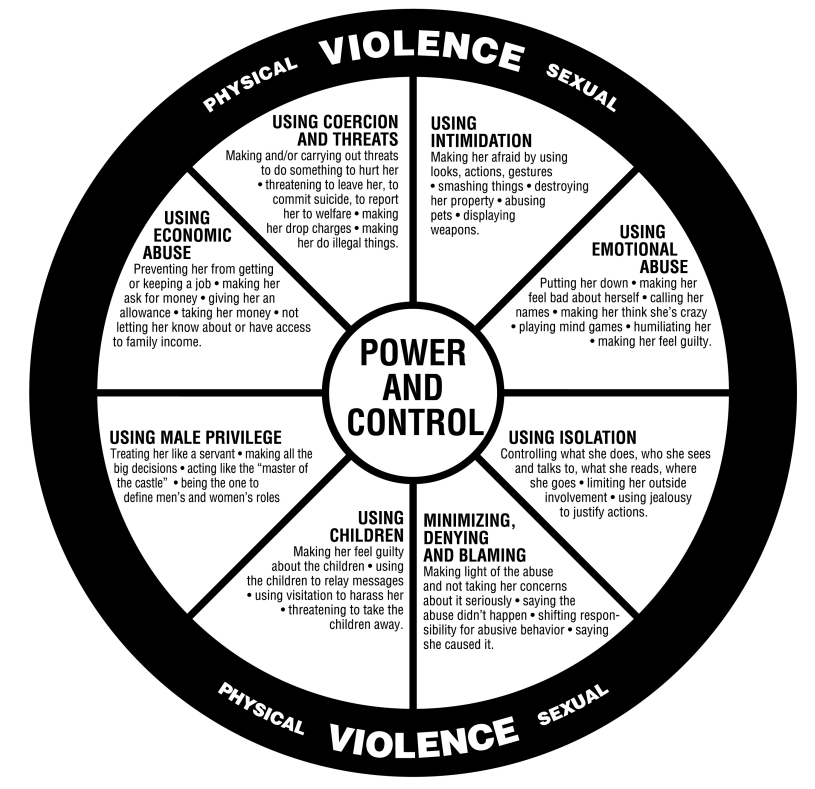
Incidents of domestic abuse that result in a crime are recorded by police and are included in recorded crime. Incidents of domestic abuse are cases that were reported to police, but following investigation, do not amount to a crime or an offence according to the National Crime Recording Standards. These can be added to domestic abuse-related crimes to create a total picture of the demand that domestic abuse puts on the police.
Domestic abuse crimes may fall into the broader category of violence and sexual offences in the Police Data UK dataset, but may fall into other categories and some domestic abuse crimes may fall into the broader ‘other crimes’ category. From the national dataset from Police Data UK, it is not possible to obtain the total number of domestic abuse crimes specifically.
The Hull Picture
The numbers of domestic abuse crimes and incidents is generally not recorded at a local authority level in the national datasets, and data tends to cover Police Areas. Humberside is the local Police Area which covers Hull, East Riding of Yorkshire, North Lincolnshire and North East Lincolnshire. Based on mid-year 2024 resident population estimates, the total population is 962,532 across this geographical areas with Hull accounting for 28.6% of the population.
Due to Hull’s increase deprivation levels and higher crime rates, it is estimated that a significant proportion of reported domestic abuse crimes and incidents will relate to Hull residents, and that it would account for a greater percentage than 28.6% based on population alone. For instance, Hull residents account for 41.7% of all hospital admissions for violence across the four local authorities for the period 2020/21 to 2022/23, 41.2% of all reported violence offences in 2022/23 and 38.8% of all reported sexual offences in 2022/23 (see Crime under Health and Wellbeing Influences). Therefore, it is probably not unreasonable to assume that Hull residents account for around 40% of domestic abuse-related crimes and incidents reported to Humberside Police.
Local information relating to domestic abuse is available for Hull from services providers such as the number of referrals to specific local services.
Not all domestic abuse-related crimes and incidents will be reported, so the numbers in the official statistics denotes only a proportion of the total number of such crimes and incidents. As well as reluctance and fear of reporting, there may be a perception that a crime or domestic abuse incident has not occurred in some cases.
Some information relating to age and gender is provided below for England & Wales as it is likely that the age and gender distribution of domestic abuse crimes and incidents is similar across most Police Force Areas, and this may provide useful information in relation to the Humberside Police Area.
Domestic Abuse in England and Wales
It is useful to examine information for England and Wales when information is not available at a local level as this can give an indication of the types of domestic abuse-related incidents and crimes and information on the perpetrators and people affected.
Crime Survey for England and Wales
From the Crime Survey for England and Wales for 2023/24, 3.0% of men and 6.6% of women had experienced domestic abuse in the last year, and 13.7% of men and 27.4% of women had experienced domestic abuse since the age of 16 years.
| Type of abuse | Perpetrator | All in last year | Men in last year | Women in last year | All since aged 16 years | Men since aged 16 years | Women since aged 16 years |
| Non-physical (emotional, financial) | Partner | 2.3 | 1.4 | 3.2 | 10.0 | 5.8 | 14.1 |
| Threats or force | Partner | 1.1 | 0.5 | 1.6 | 10.6 | 5.7 | 15.6 |
| Sexual assault | Partner | 0.2 | 0.0 | 0.4 | 4.6 | 0.8 | 8.4 |
| Stalking# | Partner | 0.7 | 0.4 | 0.9 | 5.2 | 2.2 | 8.2 |
| Non-physical (emotional, financial) | Family | 1.1 | 0.7 | 1.6 | 4.0 | 2.8 | 5.3 |
| Threats or force | Family | 0.8 | 0.7 | 0.9 | 4.9 | 4.0 | 5.9 |
| Sexual assault | Family | 0.1 | * | 0.1 | 1.4 | 0.4 | 2.4 |
| Stalking | Family | 0.3 | 0.2 | 0.4 | 2.2 | 1.2 | 3.2 |
| Any domestic abuse | Partner or family | 4.8 | 3.0 | 6.6 | 20.5 | 13.7 | 27.4 |
From the Crime Survey for England and Wales for 2023/24, across England and Wales, younger men and women were more likely to have experienced domestic abuse in the last year as were people who were single, separated or divorced, people who were unemployed, students or long-term or temporarily sick or ill, and people who were disabled, people who were bisexual.
| Group | Characteristic | Men | Women | Persons |
| Age | 16-19 | 5.8 | 11.2 | 8.7 |
| Age | 20-24 | 4.8 | 9.4 | 7.1 |
| Age | 25-34 | 3.5 | 6.9 | 5.1 |
| Age | 35-44 | 2.6 | 7.7 | 5.1 |
| Age | 45-54 | 2.6 | 7.0 | 4.8 |
| Age | 55-59 | 3.1 | 4.5 | 3.8 |
| Age | 60-74 | 2.8 | 5.0 | 4.0 |
| Age | 75+ | 0.6 | 3.5 | 2.1 |
| Marital status | Married/civil partnership | 1.9 | 3.2 | 2.5 |
| Marital status | Cohabiting | 2.9 | 7.7 | 5.1 |
| Marital status | Single | 4.6 | 10.6 | 7.6 |
| Marital status | Separated | 8.0 | 19.4 | 15.0 |
| Marital status | Divorced/legally dissolved partnership | 6.4 | 14.8 | 11.8 |
| Marital status | Widowed | 2.4 | 2.5 | 2.4 |
| Employment status | In employment | 3.3 | 6.1 | 4.6 |
| Employment status | Unemployed | 2.7 | 12.0 | 6.8 |
| Employment status | Student | 3.9 | 14.4 | 9.9 |
| Employment status | Looking after home or family | 2.6 | 9.6 | 8.4 |
| Employment status | Long-term or temporarily sick or ill | 9.1 | 15.4 | 12.9 |
| Employment status | Retired | 1.1 | 3.6 | 2.4 |
| Disability | Disabled | 4.7 | 12.7 | 9.2 |
| Disability | Not disabled | 2.7 | 5.1 | 3.9 |
| Sexual orientation | Heterosexual | 2.8 | 6.3 | 4.5 |
| Sexual orientation | Gay or lesbian | 7.6 | 3.4 | 6.0 |
| Sexual orientation | Bisexual | 3.1 | 11.2 | 9.3 |
| Hours out of home on average weekday | Less than 3 | 2.4 | 6.8 | 4.8 |
| Hours out of home on average weekday | 3 or more but less than 7 | 2.8 | 5.7 | 4.4 |
| Hours out of home on average weekday | 7 or more | 3.5 | 7.3 | 5.1 |
In terms of the people experiencing domestic abuse based on their household characteristics, the prevalence of domestic abuse was higher among single people with children aged under 16 years and people living in areas of higher deprivation (and associated with this people living in households with lower incomes, social renters and living within smaller houses).
| Group | Characteriestic | Men | Women | Persons |
| Household structure | Single person with children under 16 | * | 20.5 | 20.1 |
| Household structure | Persons with children under 16 | 3.0 | 6.1 | 4.6 |
| Household structure | Person(s) and no children | 2.9 | 5.9 | 4.4 |
| Household income | Less than £10,400 | 5.7 | 11.5 | 9.0 |
| Household income | £10,400 to £20,799 | 4.1 | 10.9 | 8.1 |
| Household income | £20,800 to £31,199 | 3.0 | 6.7 | 4.9 |
| Household income | £31,200 to £41,599 | 2.5 | 6.9 | 4.6 |
| Household income | £41,600 to £52,199 | 3.9 | 6.9 | 5.3 |
| Household income | £52,200 or more | 3.1 | 4.3 | 3.7 |
| Tenure | Owners | 2.2 | 5.1 | 3.7 |
| Tenure | Social renters | 5.3 | 11.8 | 9.1 |
| Tenure | Private renters | 4.2 | 8.1 | 6.0 |
| Accommodation | Detached | 2.0 | 4.9 | 3.4 |
| Accommodation | Semi-detached | 2.9 | 6.5 | 4.7 |
| Accommodation | Terraced | 3.8 | 7.1 | 5.5 |
| Accommodation | Flats/maisonettes | 3.7 | 8.8 | 6.1 |
| Area type | Urban | 3.1 | 6.4 | 4.8 |
| Area type | Rural | 2.4 | 7.2 | 4.9 |
| Deprivation | Most deprived fifth | 3.6 | 8.9 | 6.3 |
| Deprivation | Intermediate three-fifths | 2.8 | 6.3 | 4.6 |
| Deprivation | Least deprived fifth | 2.8 | 4.4 | 3.6 |
Offences Reported to the Police
During 2023/24, there were 851,062 offences recorded by the police which were identified as domestic abuse-related across England and Wales, and more than three-quarters of these were violence against the person offences.
One-third of all violence against the person offences were domestic abuse-related, and almost one-fifth of all sexual offences were domestic abuse-related.
| Offence | Number of domestic abuse-related offences | Percentage of domestic abuse-related offences | Percentage of total offences that were domestic abuse-related |
| Violence against the person | 670,168 | 78.7 | 33.3 |
| Sexual offences | 35,681 | 4.2 | 18.9 |
| Miscellaneous crimes | 13,481 | 1.6 | 11.8 |
| Criminal damage and arson | 51,139 | 6.0 | 10.3 |
| Public order offences | 34,321 | 4.0 | 7.0 |
| Other offence types | 46,272 | 5.4 | 2.2 |
| All offences | 851,062 | 100.0 | 15.8 |
Across Humberside Police Area and Compared to Other Areas
Domestic Abuse Crimes and Incidents
The number of domestic abuse-related crimes has increased across the Humberside Police Area over time, although it is likely that the data recording has improved over time with more domestic abuse-related crimes recorded as such in the last few years.
Across the Humberside Police Area, there had been just over 16,000 domestic abuse-related crimes recorded during each financial year between 2018/19 and 2021/22, but this fell to around 15,500 in 2022/23. However, there has been an increase in the latest year to almost 17,400 domestic abuse-related crimes recorded for 2023/24.
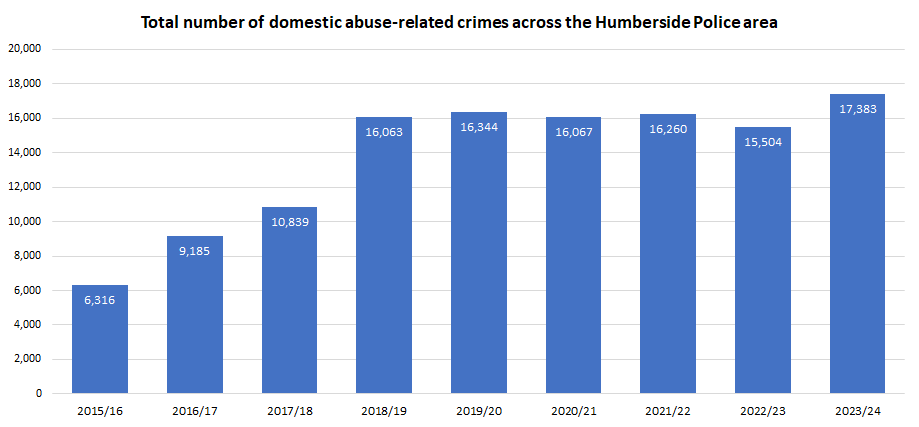
Domestic abuse-related crimes make up a high proportion of total crimes. One in ten of all crimes were domestic abuse-related in 2015/16 but this has increased to around one in six in 2023/24. This could also be due to better reporting of domestic abuse-related crimes. In 2015/16, the percentage was lower in Humberside than both England and across the Yorkshire and Humber region, but for the majority of the subsequent years, the percentage across Humberside was generally higher than the England but lower than the region. For the latest year 2023/24, the percentage in Hull is higher than both the region and England.
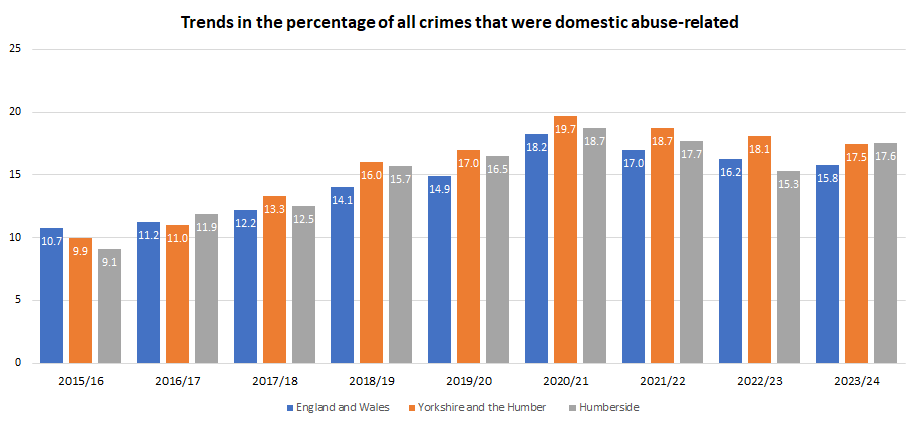
Out of the 39 Police Force areas across England and Wales with data available, Humberside was ranked as the seventh highest for the rate of all domestic abuse-related crimes per 1,000 population for 2023/24 with 18.4 crimes per 1,000 population compared to Cleveland which had the highest (24.1) and Surrey which had the lowest (7.1).
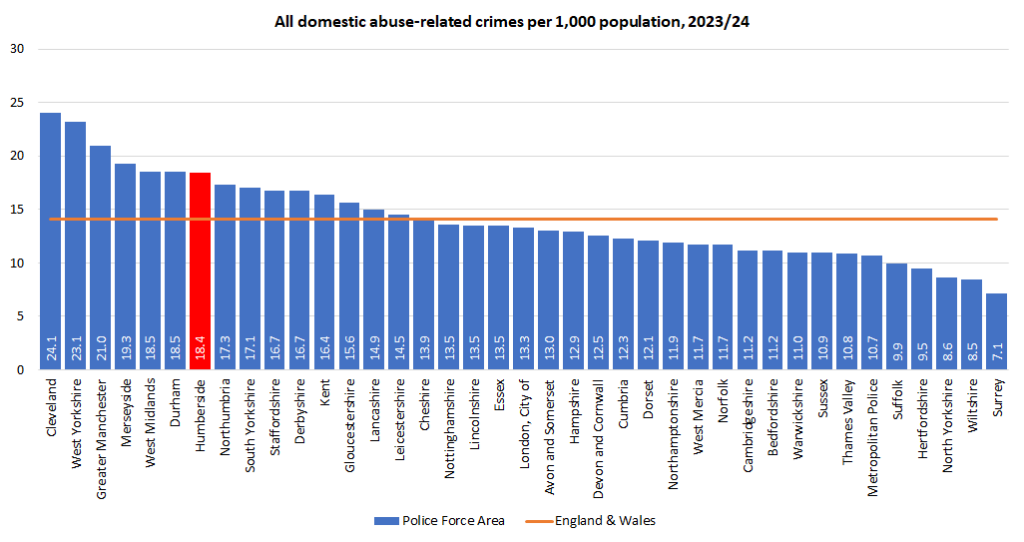
Across England and Wales for 2023/24, there were 851,062 offences recorded by police which were identified as domestic abuse-related representing 15.8% of recorded offences. One-third (33.3%) were violence against the person, 18.9% were sexual offences, 7.0% were public order offences, 10.3% were criminal damage and arson crimes, 11.8% were recorded as miscellaneous crimes and 2.2% were other types of offences.
The total number of domestic abuse-related incidents was decreased during the pandemic, and fell sharply between 2021/22 and 2022/23 across Humberside Police Area although it has increased in 2023/24 with almost 10,600 incidents.
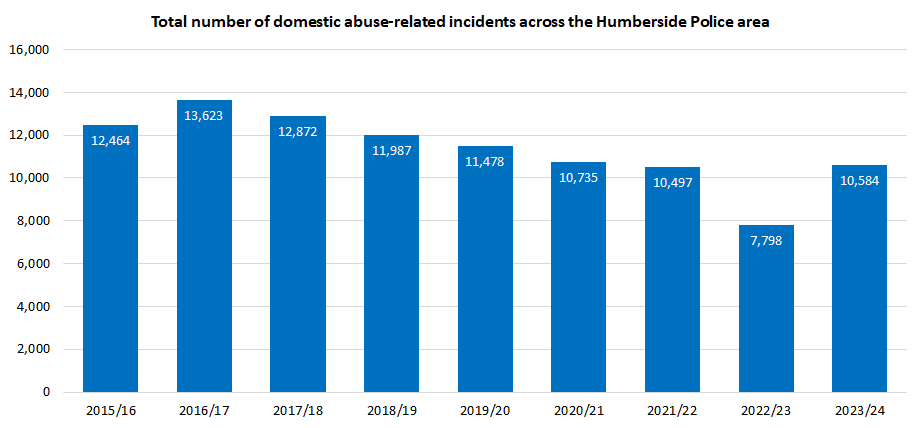
Violence Against the Person Crimes
Across England and Wales for 2023/24, 46.7% of persons offences against a person were domestic abuse-related among women compared to 22.9% for men. For women, the percentages increased from 40% among women aged 16-19 years to 51% among women aged 30-34 years before decreasing to 38% among women aged 75+ years. For men, the percentages increased from 21% among men aged 16-19 years to 25% among men aged 35-39 years before decreasing to 22% for men aged 60-64 years, although rates were highest among older men (25% for 65-69s, 26% for 70-74s and 27% for 75+).
The total number of violence against the person domestic abuse-related offences has increased significantly over time across the Humberside Police Area, but the increase between 2015/16 and 2018/19 could have been due to better recording of domestic abuse-related crimes. Over the last five years, there have been around 12,000 violence against the person offences that were domestic abuse-related each year across the Humberside Police Area, just under 12,000 in 2022/23 although there has been an increase in the latest year 2023/24 to almost 13,400 crimes.
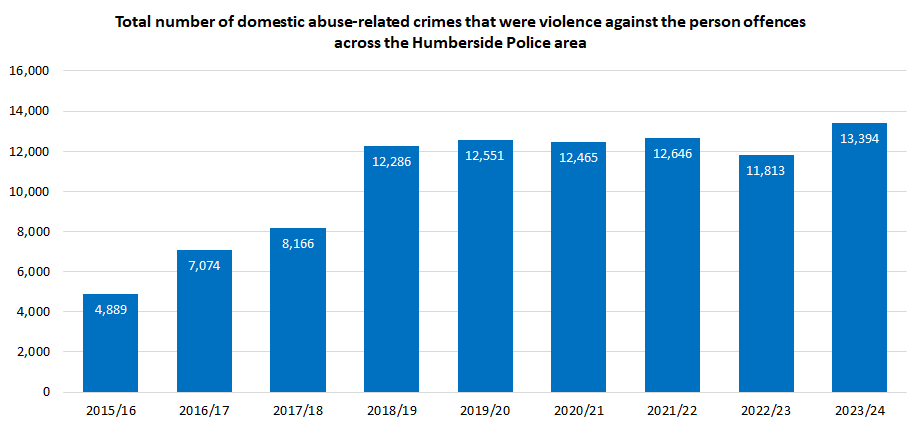
The percentage of violent offences that were domestic abuse-related had increased over time between 2015/16 and 2020/21, but decreased in both 2021/22 and 2022/23. Whilst there has been an increase for 2023/24, the percentage is lower than the peak in 2020/21.
For the latest year 2023/24, just under one-third of all crimes were domestic abuse-related violence against the person offences in the Humberside Police Force area which was lower than both the region and England and Wales.
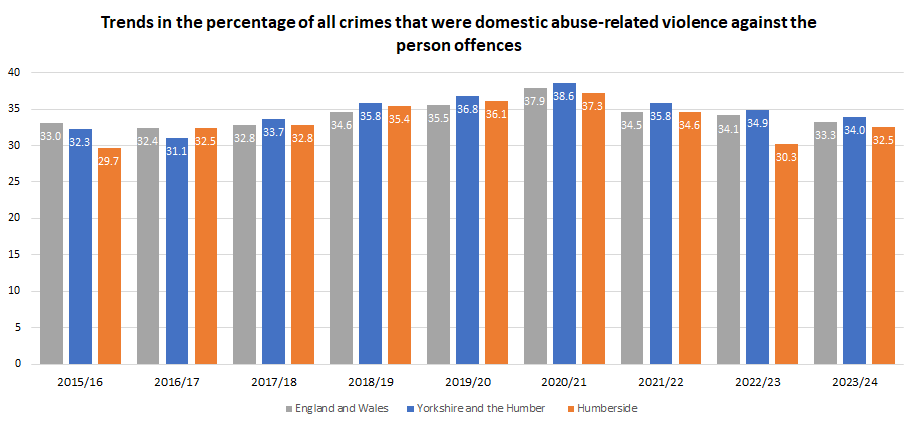
Out of the 39 Police Force Areas across England and Wales with data available, Humberside was ranked as the sixth joint highest for the rate of violence against the person domestic abuse-related crimes per 1,000 population for 2023/24 with 14.2 such crimes per 1,000 population. West Yorkshire had the highest rate at 18.0 such crimes per 1,000 population and Surrey the lowest rate at 5.8 crimes per 1,000 population.
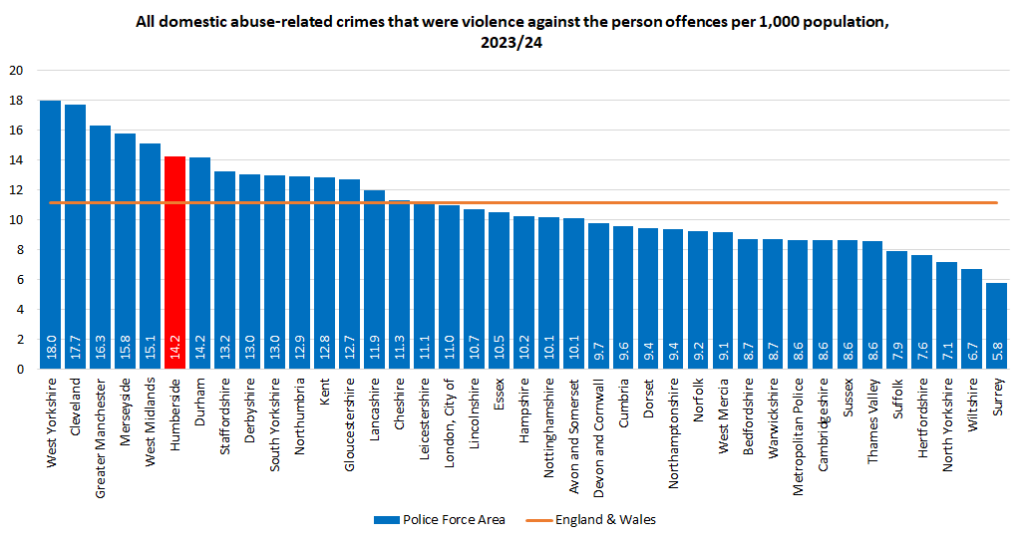
Across England and Wales for 2023/24, of the domestic-abuse related violence against the person offences recorded by police, 37% were stalking and harassment (6% controlling and coercive behaviour, 8% harassment, 6% malicious communications and 16% stalking), 27% were violence with injury and 37% were violence without injury (33% assault without injury and 3% threats to kill).
Sexual Offences
For 2023/24, across England and Wales, the percentage of sexual offences recorded by the police that were identified as domestic abuse-related increased from 16% among women aged 16-19 years to a peak of 39% among women aged 35-39 years before gradually decreasing to 20% among women aged 7-74 years with the lowest percentage of 9% among women aged 75+ years. Among males, a similar pattern with age occurred although the percentages were around half those for females. Among men aged 16-19 years 10% of sexual offences recorded by the police were identified as domestic abuse-related which increased to 17% among men aged 35-39 years before decreasing to 4-5% among men aged 70+ years. Over all age groups, 29% of sexual offences recorded by the police that were identified as domestic abuse-related among women compared to 13% among men.
Stalking and Harassment Offences
Across England and Wales for 2023/24, there were 203,138 domestic abuse-related stalking and harassment offences recorded by police.
Across the Humberside Police Force Area, there were 4,931 domestic abuse-related stalking and harassment offences during 20232/24 (ranked 15 highest out of 39 Police Force areas with data). The total number will depend on the total population and the size of the geographical area of the Police Force Area.
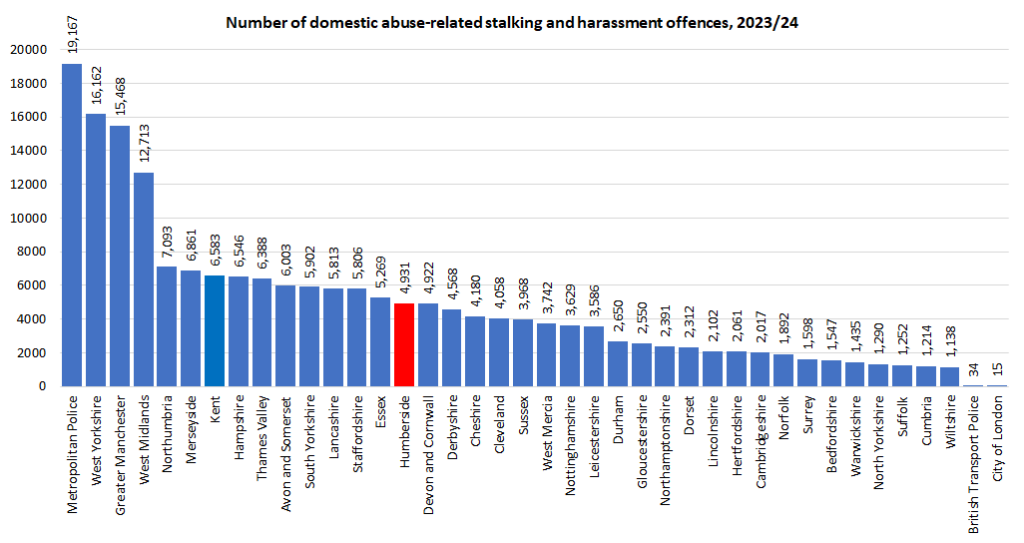
The percentage of stalking and harassment offences that were domestic abuse-related in 2023/24 varied considerably across the 39 Police Force Areas from 41.7% in Northumbria to 11.3% for City of London, and this may be a reflection of the way in which different Police Force Areas record the information (whilst there is a new system in place it is not fully in use by all Police Force Areas).
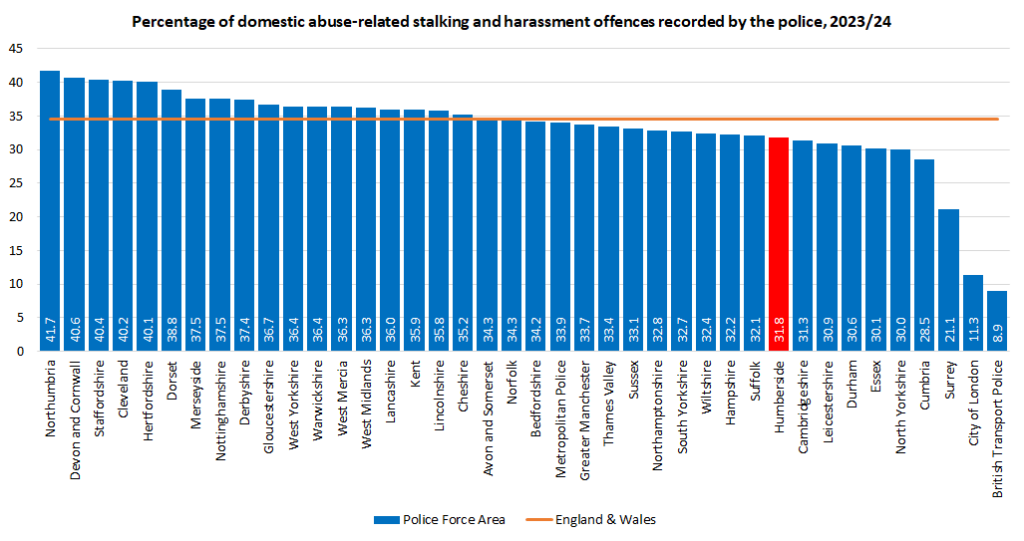
Coercive Control Offences
There were 45,310 coercive control offences recorded by police across England and Wales during 2023/24 including 645 for Humberside Police Force Area. The total numbers varied dramatically from 14 to 5,945 across the 39 police areas. However, the number will depend on the size of the geographical area in terms of the population served by the Police Force Area. There may also be differences due to the way information is recorded (whilst there is a new system in place it is not fully in use by all Police Force Areas).
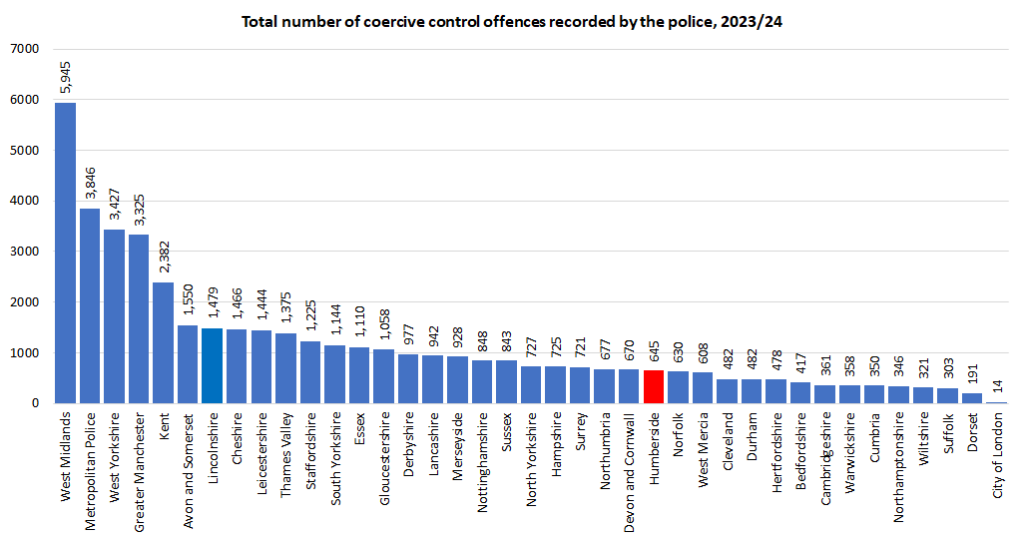
Homicides
Across England and Wales there were 1,831 victim of homicide over the three year period 2020/21 to 2022/23 of which 353 were domestic homicides, 875 non-domestic homicides and 165 were victims aged under 16 years with 436 victims aged 16+ years where no suspect was identified. There were more than twice as many male victims as women (1,308 versus 521), but a higher percentage were domestic homicides among women (44%) compared to men (9%). A similar percentage had no suspect identified (24%), but a much higher percentage were non-domestic among men (59%) compared to women (21%). Whilst the numbers aged under 16 years was almost twice as high among men (107) compared to women (57), they accounted for a slightly higher percentage of all homicides among women compared to men (11% versus 8%).
Across the Humberside Police area over the three year period 2020/21 to 2022/23, there were 28 homicides in total with one victim aged under 16 years, six were identified as domestic homicides and 16 were non-domestic homicides with the no suspect identified for five homicides. Overall, six of the 28 homicides were among women of which four were domestic with no suspect identified for the remaining two homicides. There were 22 homicides among men including one victim aged under 16 years. Two of the 22 homicides among men were domestic homicides, 16 were non-domestic and no suspect was identified for the remaining three homicides.
Across England and Wales, the average age of the victim was 49 years for domestic homicides and 50 years for non-domestic homicides compared to 51 years for domestic homicides and 27 years for non-domestic homicides for men. Among the domestic homicides across England and Wales during the three year period 2020/21 to 2022/23, the highest percentage of victims was among those aged 75+ years (15% for women and 20% for men). Among females, 8% were aged under 25 years, 18% aged 25-34 years, 18% aged 35-44 years, 22% aged 45-54 years, 13% aged 55-64 years and 22% aged 65+ years. Among males, 11% were aged under 25 years, 15% aged 25-34 years, 12% aged 35-44 years, 21% aged 45-54 years, 17% aged 55-64 years and 25% aged 65+ years. In six in ten domestic homicides where the victim was aged 16+ years, the suspect was the partner or ex-partner (75% for female and 33% for male victims), 24% a parent (18% for female and 34% for male victims), 1.7% a child (2.2% for female and 0.8% for male victims) and 14% other family member (5.2% for female and 32.0% for male victims). For 122 of the homicides, a female suspect was identified in 39 cases (with the victim a female in seven cases and a male in 39 cases) and a male suspect identified in 307 cases (with the victim a female in 224 cases and a male in 83 cases).
Within Hull
For the period April 2021 to March 2022, there were 3,124 referrals to Hull’s Domestic Abuse Partnership with 1,202 of these were not previously known to the service. Overall, 21% are repeat referrals. Each month there was an average of 620 victims receiving support, with 895 children linked to the family.
Overall, 40% of these open cases were classified as high risk, 57% as medium and 3.0% as low risk.
A total of 1,251 adult victims (aged 16+ years) were assessed as being at high risk of significant harm or homicide and were discussed at Multi-Agency Risk Assessment Conference (MARAC). This included 13 victims were aged 16 or 17 years, and 14 of those who were harming high cases listed were aged 16 or 17 years. The 1,251 adult victims were linked to 990 children living within the household.
Overall, 528 victims and their children were supported to remain within their own homes with Sanctuary scheme measures meaning they wasn’t forced to leave their homes, family and support networks.
In 2021/22, 144 men called the Strength to Change voluntary perpetrator programme helpline. On average there are 50 men accessing support to reduce and stop harming those they are in an intimate relationship with. On average there were 75 current or ex-partners also receiving support. During this time 45 men fully completed the programme.
During April 2020 and March 2022, there were 13,354 contacts with Hull City Council Children and Young Peoples Services, and of these contacts 3,528 were due to domestic abuse. The total number of referrals received was 4,858, and of these 1,457 were due to domestic abuse.
Hull City Council commissions two specialist domestic abuse providers Hull Women’s Aid and Preston Road Women’s Centre to provide support to victim and their children impacted by domestic abuse in the city. During April 2020 and March 2021 Hull Women’s aid accommodated 59 women and 134 children with an average stay of 77 days. They also supported 207 women living in their own homes. Their children and young people service supported 144 children and young people. Preston Road Women’s Centre supported 636 clients.
Out of the 42 police force areas with data available in 2022/23 Humberside police ranked number 16 for the number of domestic abuse reported incidents and 16% of all crimes reported were domestic abuse related. In Hull alone Humberside police responded to 10,883 incidents of domestic abuse, of which 7,508 was recorded as a crime.
The rate of domestic abuse-related incidents and crimes in 2023/24 was 36.1 per 1,000 population across the Humberside area which is higher than England (27.1). Humberside Police covers Hull, East Riding of Yorkshire, North Lincolnshire and North East Lincolnshire, and all four local authorities have the same rate of domestic abuse-related incidents and crimes figure, although in practice, it is likely that the rate will differ and is probably considerably higher in Hull. The local needs assessment of Multiple Unmet Need found that violent crime rates were 69% higher than England, and that Hull residents accounted for 50% of all first time offenders and 40% of all proven re-offenders and re-offences across the Humberside Police Area, so it is probably not unreasonable to assume that 45% of all domestic abuse related incidents and crimes within the Humberside Police Area relate to Hull residents.
Compared with benchmark
| Indicator | Period | England | Yorkshire and the Humber region (statistical) | Kingston upon Hull | East Riding of Yorkshire | North East Lincolnshire | North Lincolnshire | York | North Yorkshire UA | Barnsley | Doncaster | Rotherham | Sheffield | Bradford | Calderdale | Kirklees | Leeds | Wakefield |
|---|---|---|---|---|---|---|---|---|---|---|---|---|---|---|---|---|---|---|
Domestic abuse related incidents and crimes (Persons 16+ yrs) | 2023/24 | 27.1 | 34.6 | 36.1 | 36.1 | 36.1 | 36.1 | 16.0 | 16.0 | 32.9 | 32.9 | 32.9 | 32.9 | 41.8 | 41.8 | 41.8 | 41.8 | 41.8 |
| Indicator | Period | England | Yorkshire and the Humber region (statistical) | Kingston upon Hull | East Riding of Yorkshire | North East Lincolnshire | North Lincolnshire | York | North Yorkshire UA | Barnsley | Doncaster | Rotherham | Sheffield | Bradford | Calderdale | Kirklees | Leeds | Wakefield |
|---|---|---|---|---|---|---|---|---|---|---|---|---|---|---|---|---|---|---|
Domestic abuse related incidents and crimes (Persons 16+ yrs) | 2023/24 | 27.1 | 34.6 | 36.1 | 36.1 | 36.1 | 36.1 | 16.0 | 16.0 | 32.9 | 32.9 | 32.9 | 32.9 | 41.8 | 41.8 | 41.8 | 41.8 | 41.8 |
Rates of domestic abuse-related incidents and crimes increased between 2015/16 and 2018/19 for Hull, although some of the increase could be associated with better reporting. Between 2018/19 and 2022/23, the rate decreased especially between 2021/22 and 2022/23, but there has been an increase in the last year. The rate in Hull is among the highest it has been.
Anecdotally it has been suggested that the rate of domestic abuse has increased in Hull, particularly during the pandemic. Local services have recently seen a 100% increase in demand as reported in the needs assessment of Multiple Unmet Need. Furthermore, not all domestic abuse will be reported or recorded as such if it were reported. This is not particularly evident in the levels of recorded domestic abuse presented here, although as stated earlier the figures on Fingertips relate to the whole of the Humberside Police Area and only represent a proportion of domestic abuse as there will be many cases that are not reported to the police.
Compared with benchmark
Domestic abuse related incidents and crimes (Persons 16+ yrs)
|
Period
|
Kingston upon Hull |
Yorkshire and the Humber region (statistical)
|
England
|
||||
|---|---|---|---|---|---|---|---|
|
Count
|
Value
|
95%
Lower CI |
95%
Upper CI |
||||
| 2015/16 | • | - | 24.8 | - | - | 24.6 | 22.1 |
| 2016/17 | • | - | 30.0 | - | - | 26.4 | 22.6 |
| 2017/18 | • | - | 31.1 | - | - | 28.4 | 23.7 |
| 2018/19 | • | - | 36.6 | - | - | 32.8 | 25.8 |
| 2019/20 | • | - | 36.3 | - | - | 32.7 | 26.5 |
| 2020/21 | • | - | 34.9 | - | - | 34.5 | 28.1 |
| 2021/22 | • | - | 34.8 | - | - | 36.5 | 28.6 |
| 2022/23 | • | - | 30.2 | - | - | 36.3 | 28.3 |
| 2023/24 | • | - | 36.1 | - | - | 34.6 | 27.1 |
Source: Office for National Statistics
Over the three year period 2021/22-2023/24, the rate of hospital admissions for violence including sexual violence was high in Hull at 56.1 per 100,000 population compared to England (34.1 per 100,000 population). A subset of these hospital admissions could be related to domestic abuse.
Violent crime rates involving hospital admission, violent crime rates relating to sexual offences and violent crime rates were all considerably higher in Hull compared to England (further information on these crimes is given under Crime within Health and Wellbeing Influences).
Compared with benchmark
| Indicator | Period | England | Yorkshire and the Humber region (statistical) | Kingston upon Hull | East Riding of Yorkshire | North East Lincolnshire | North Lincolnshire | York | North Yorkshire UA | Barnsley | Doncaster | Rotherham | Sheffield | Bradford | Calderdale | Kirklees | Leeds | Wakefield |
|---|---|---|---|---|---|---|---|---|---|---|---|---|---|---|---|---|---|---|
Violent crime - hospital admissions for violence (including sexual violence) (Persons All ages) | 2021/22 - 23/24 | 34.2 | 40.1 | 56.1 | 27.9 | 58.0 | 41.4 | 32.5 | 27.0 | 72.1 | 53.4 | 45.6 | 47.1 | 32.9 | 36.6 | 40.2 | 29.1 | 52.1 |
| Indicator | Period | England | Yorkshire and the Humber region (statistical) | Kingston upon Hull | East Riding of Yorkshire | North East Lincolnshire | North Lincolnshire | York | North Yorkshire UA | Barnsley | Doncaster | Rotherham | Sheffield | Bradford | Calderdale | Kirklees | Leeds | Wakefield |
|---|---|---|---|---|---|---|---|---|---|---|---|---|---|---|---|---|---|---|
Violent crime - hospital admissions for violence (including sexual violence) (Persons All ages) | 2021/22 - 23/24 | 34.2 | 40.1 | 56.1 | 27.9 | 58.0 | 41.4 | 32.5 | 27.0 | 72.1 | 53.4 | 45.6 | 47.1 | 32.9 | 36.6 | 40.2 | 29.1 | 52.1 |
The rate of hospital admissions for violence including sexual violence has been decreasing in Hull over time, but there were 465 recorded admissions over the three year period 2021/22-2023/24 equating to an average of 155 per year.
Compared with benchmark
Violent crime - hospital admissions for violence (including sexual violence) (Persons All ages)
|
Period
|
Kingston upon Hull |
Yorkshire and the Humber region (statistical)
|
England
|
||||
|---|---|---|---|---|---|---|---|
|
Count
|
Value
|
95%
Lower CI |
95%
Upper CI |
||||
| 2009/10 - 11/12 | • | 934 | 108.3 | 101.3 | 115.6 | 76.7 | 61.7 |
| 2010/11 - 12/13 | • | 790 | 91.6 | 85.2 | 98.4 | 73.0 | 56.6 |
| 2011/12 - 13/14 | • | 710 | 83.1 | 77.0 | 89.6 | 68.1 | 51.5 |
| 2012/13 - 14/15 | • | 610 | 71.5 | 65.9 | 77.5 | 60.9 | 46.6 |
| 2013/14 - 15/16 | • | 580 | 68.6 | 63.0 | 74.5 | 57.4 | 44.6 |
| 2014/15 - 16/17 | • | 540 | 63.6 | 58.3 | 69.3 | 53.9 | 42.7 |
| 2015/16 - 17/18 | • | 545 | 63.7 | 58.3 | 69.4 | 53.5 | 43.2 |
| 2016/17 - 18/19 | • | 540 | 63.1 | 57.8 | 68.8 | 54.6 | 44.7 |
| 2017/18 - 19/20 | • | 535 | 62.8 | 57.5 | 68.4 | 53.8 | 45.5 |
| 2018/19 - 20/21 | • | 485 | 57.7 | 52.6 | 63.1 | 47.7 | 41.7 |
| 2019/20 - 21/22 | • | 425 | 50.9 | 46.1 | 56.1 | 42.9 | 38.4 |
| 2020/21 - 22/23 | • | 425 | 50.9 | 46.1 | 56.1 | 39.0 | 34.3 |
| 2021/22 - 23/24 | • | 465 | 56.1 | 51.1 | 61.5 | 40.1 | 34.2 |
Source: OHID, based on NHS England and Office for National Statistics data
Local work has involved development of ‘Is your relationship healthy?’ campaign posters in conjunction with young people in Hull. There has also been numerous training events specifically around children and young people to raise awareness of domestic abuse and prevent domestic abuse for future generations. Hull is a White Ribbon City, and in 2019 during the 16 days of action, 27 primary schools and one secondary school were involved in work which aims to raise awareness of healthy and respectful relationships. Overall, 24,240 children, parents and staff signed the children or adult White Ribbon pledge. Teacher training sessions relating to The Expect Respect Educational Toolkit have been delivered in more than 50 primary and secondary schools, with 124 staff working with children and young people, and 40 early years staff. This work has continued throughout the period from 2020 to 2022 during the COVID-19 pandemic with schools working independently to ensure the white ribbon messages have been imbedded in schools across the city.
Strategic Need and Service Provision
In April 2020 the Domestic Act was given royal assent and introduced for the first time a national definition of domestic abuse and recognises children and young people as victims of domestic abuse if they see, hear, or experience the effects of the abuse, and are related to either the victim or perpetrator.
A key element of the Act is the creation of a statutory duty on local authorities to comprehensively assess the level of need for domestic abuse safe accommodation within their local area and to publish a Domestic Abuse Strategy outlining the steps to be taken to ensure these needs are met. In order to meet these requirements Hull City Council, with support from partner agencies, local residents and survivors, have completed an Equality Impact Analysis. The purpose of this was to establish to what extent the current service provision in relation to domestic abuse safe accommodation and allied support meets the needs of diverse victims and their children in Hull and to identify whether there are gaps in the current offer and any barriers to accessing appropriate support. Additionally, the refreshed strategy takes information and evidence from the following:
- Co-production through the voices of victims with lived experience and who are experts in domestic abuse;
- Violence Against Women and Girls Strategy 2021;
- Community Safety Partnership Strategy;
- Strategic Domestic Abuse Board;
- Hull Collaborative Partnership;
- Lessons learnt from Domestic Homicide Reviews and Child Serious Case reviews; and
- Scrutiny Report commissioned by the Hull Safeguarding Children Partnership (HSCP) which was completed in September 2021. This report focussed specifically on the impact of domestic abuse on children and young people and the effectiveness of service provision for them.
This Strategy and aligned Delivery Plan outline how the ‘new burdens’ grant awarded to the Local Authority will be deployed to meet those identified needs and where future funding will be directed. The key priorities and their commitments are for all irrespective of gender, sex, age, disability, ethnicity, sexual orientation and religion. Recognising intersectionality of these characteristics, as evidenced and reflected in the Equalities Impact Analysis and detailed in the Delivery Plan.
The four key priorities in Hull’s Domestic Abuse Strategy 2021-2024 are:
- Priority 1: Preventing domestic abuse through early identification and intervention.
- Priority 2: Provision of high-quality services.
- Priority 3: Pursuing perpetrators and seeking justice. (The Domestic Abuse Act 2021 states that a perpetrator strategy is being developed and when published will result in this priority being reviewed to ensure key themes and messages are included.)
- Priority 4: Partnership working, workforce development and co-production.
Each person’s experience of domestic abuse is unique to them. Not all victims want or are able to leave their abuser at a particular time, and abuse can begin, continue or escalate post-separation. Many victims may not seek to pursue a criminal justice outcome, and so appropriate support must always be offered. The experiences of children and young people who are living with domestic abuse must always be considered and their needs taken into account in any decisions made about the adult victim. Domestic abuse can encompass a wide range of behaviours and does not always include physical violence and can include emotional, psychological, controlling, or coercive, sexual and/or economic abuse. Many victims will experience these abusive behaviours simultaneously. At the centre of all these abusive behaviours is the perpetrator’s desire to exercise power and control over the victim. In recognition of this a new offence of Coercive and controlling behaviour was introduced in December 2015 in the Serious Crime Act 2015.
There are a number of services available in Hull to support domestic abuse victims and work with perpetrators such as the Hull Domestic Abuse Partnership, Hull Women’s Aid and Preston Road Women’s Centre, and Strength to Change, who work closely with other agencies in the city. Domestic abuse is a complex issue which requires a co-ordinated community response in order to ensure the needs of all those impacted by domestic abuse are met.
People’s circumstances can often be improved by early help, and any early help and intervention for all families should be timely, accessible and appropriate for their circumstances. The sooner domestic abuse is identified, and victims and their children offered support and intervention the better. As this will reduce the risk of escalation and serious harm taking place for victims, children and young people.
Resources
Home Office, Guidance: Domestic violence and abuse. 2016, Home Office: London.
Evidence and policy review: domestic violence and poverty. University of Bristol (supported by the Joseph Rowntree Foundation), 2015.
Unicef. Behind Closed Doors: The impact of domestic abuse on children.
Ending violence against women and girls: Action plan 2016-2020 – progress update. HM Government, March 2019.
How widespread is domestic abuse and what is the impact? Safe Lives: London, 2015.
Getting it right first time. Safe Lives: Bristol, 2015.
In Plain Sight: Effective help for children exposed to domestic abuse: second national policy report. Safe Lives (formerly Caada): Bristol, 2014.
National Center for Injury Prevention and Control and Division of Violence Prevention, Intimate Partner Violence: Consequences. www.cdc.gov. 2017, National Center for Injury Prevention and Control, Division of Violence Prevention: Atlanta, USA.
Heise, L. and C. Garcia-Moreno, Violence by intimate partners., in World report on violence and health, E. Krug, et al., Editors. 2002, World Health Organisation: Geneva, Switzerland. p. 87-121.
Coker, A.L., et al., Physical and mental health effects of intimate partner violence for men and women. American Journal of Preventative Medicine, 2002. 23(4): p. 260-268.
Roberts, T.A., J.D. Klein, and S. Fisher, Longitudinal effects of intimate partner abuse on high-risk behavior among adolescents. Archives of Pediatric Adolescent Medicine, 2003. 157(9): p. 875-981.
Warshaw, C., B. Brashler, and J. Gil, Mental health consequences of intimate partner violence., in Intimate partner violence: a health-based perspective., C. Mitchell and D. Anglin, Editors. 2009, Oxford University Press: New York. p. 147-171.
Black, M.C., Intimate partner violence and adverse health consequences: implications for clinicians. American Journal of Lifestyle Medicine, 2011. 5(5): p. 428-439.
Golding, J., Intimate partner violence as a risk factor for mental disorders: a meta-analysis. Journal of Family Violence, 1999. 14(2): p. 99-132.
Howard, L.M., et al., Domestic violence and severe psychiatric disorders: prevalence and interventions., in Psychological Medicine. 2010, Cambridge University Press: Cambridge. p. 881-893.
Office for National Statistics, Domestic abuse in England and Wales: year ending March 2018. Office for National Statistics: London, 2018.
The Office for Health Improvement & Disparities’ Fingertips: https://fingertips.phe.org.uk/
Hull’s Domestic Abuse Strategy 2021-2024. Hull Community Safety Partnership, 2021.
Strength to Change – Confidential Advice for Men in Hull: www.hullstrengthtochange.org
Hull Domestic Abuse Partnership: www.hulldap.co.uk
Hull Women’s Aid: www.hullwomensaid.org
Hull’s Early Help and Prevention Strategy 2021-25. https://www.hull.gov.uk/downloads/file/1726/Hull_Early_Help_and_Prevention_Strategy_2021_25.pdf
Updates
This page was last updated / checked on 27 October 2025.
This page is due to be updated / checked in February 2026.